15 Best Headless Commerce Platforms: 5 Reasons To Go Headless

Guess what’s common between Nike, United Airlines, and Target? They use headless commerce platforms to create faster and more customized websites.
But what makes them switch to headless commerce or progressive web app development from traditional eCommerce development?
Is it the customization flexibility? Is it more control over the front and the back end? Or is it a faster development process? Well, what if I told you— all of them?
In the given article, I will give you some reasons to follow the headless route of these huge companies. In fact, I have a list of many successful industries that have implemented headless PWA.
I will also hand you the list of platforms with their features and benefits. The list will make it easier for you to choose one and achieve your commerce endeavors.
So without further ado, let’s jump onto headless commerce platforms.
What Is A Headless Commerce Platform?
A headless commerce platform is a platform that separates content management applications from the content delivery application environment.
If
- you’re good with your existing front-end solution, and
- want a bit more from your backend system,
a headless commerce platform will convert your objective into reality.
In simple terms, the headless commerce platforms accomplish your headless commerce dreams.
Things you can do with the headless commerce platforms:
- Connect backends with multiple frontends
- Deliver faster content to all the digital touchpoints
Traditional eCommerce platforms force their architecture on you. You can only choose from the templates they provide.
What Are The Benefits Of Headless Commerce Platforms?
Decoupling is good, but headless commerce platforms can benefit you more than one way. It affects your eCommerce in ways you’re not even aware of.
Let’s get them one by one.
Headless platform benefit #1: Built-in Cost-Saving Capabilities
A lot of people think headless commerce platforms are expensive.
It makes sense if you are not counting the cost of inefficiencies. But headless platforms have removed unmeasured redundancies time and again.
If you don’t measure them— you don’t know how much you’re saving in the long term. Let’s keep it this way. You can dismiss the claims if you can measure these elements. Ask yourself:
- How many redundancies do headless platforms reduce?
- What is the cost of seamless integration between both ends?
- What’s the cost of time-consuming and expensive workarounds of creating an omnichannel experience on mobile and web?
- What’s the hidden cost of sticking to the traditional platform?
- How much time do you save with customization control?
Are you getting the point? The implementation cost with headless commerce is not fixed at all. So you can’t really claim if it’s truly more expensive than traditional commerce.
Headless platform benefit #2: Flexibility, efficiency, and adaptability
Your consumers are not buying on websites alone.
- 250 million are shopping on the Facebook marketplace. (1)
- Instagram is not far behind. 44% of surveyed people shop on Instagram. (2)
And then there’s this crazy number. 33.2 million Americans are looking to shop using smart speakers in 2022. (3)
The number of buying channels keeps increasing.
You have two approaches to it.
- Either you pick up the traditional method and repurpose digital content on all the channels.
- Or you pick a headless commerce platform approach to create flexible content on all the channels.
Headless eCommerce platforms let you make changes to the content layer. And guess what? You don’t even need to disrupt the back-end. Your team can launch content campaigns and promotions without touching the system.
So headless platforms separate the interdependency between the marketing and IT department.
Headless platform benefit #3: Better security and protected data
There’s always an unexplained urge to install third-party eCommerce solutions on your website. They’re
- lucrative,
- useful, and
- problem-solving.
But they also have downsides. You drop in a chink on the website every time you install such solutions.
- Your business becomes insecure.
- Malware and unauthorized access may affect your data.
Headless commerce platforms are designed to fill in these security chinks. What makes them more secure? Headless platforms
- are built on open-source software
- run within an isolated environment
- prevent backend code from accessing disk space
You may say staying up to date on the security vulnerabilities will do the job for you. But it’s nearly impossible. To keep up to date with all the security updates is a nut nobody wants to crack. You know they keep getting released every day..
The headless commerce platform lets you get over all these hassles. You don’t have to worry about regular updates because headless commerce already saves you from boatloads of cyber threats.
Headless platform benefit #4: You have a head start in the market
You don’t go about reinventing the light bulb. Do you? Then why would you write a codebase that’s been written and tested over and over the years? Headless commerce platforms apply the same principle to your eCommerce endeavors.
You can launch and relaunch your website at speed you can never imagine.
You don’t need Shopify or Magento web developers to start coding for your website from scratch. How do headless platforms let you early in the market? Well, that’s how you reduce the need for developers, if not eliminate it. In the process, you save
- money from hiring expensive external developers
- time and reduce the total turnaround time to launch a website
Plus, there are no licensing and vendor-related issues. So you save more time from the unnecessary delays.
Speeding up the development process = faster penetration into the market = first-movers advantages
Headless platform benefit #5: You have better control over marketing campaigns
Any business is about speaking to your customers the way you want. But traditional eCommerce platforms limit the way you deliver marketing materials to them.
But in our case, headless commerce platforms divorce the front end from the backend. You know how the two ends are not tightly coupled. This way you can innovate your marketing campaigns without getting disturbed at the back-end.
Let’s see how you can improve your marketing initiatives.
- You can roll out new initiatives. Headless commerce platforms use API to pull data from the central repository.
- The platform lets you launch microsites, blogs, storefronts, and an ‘n’ number of online store experiences without having you go through the hassle of multiple platforms. Yes, you can connect with all these touchpoints to a single platform.
- You can create consistency between channels. Web to mobile! Headless implementation is just flexible enough to bring consistency to your marketing efforts.
- If you’re accustomed to any particular CMS, you can use the design options it offers.
What are the Best Headless Ecommerce Platforms?
I have created a list of the ten best headless commerce platforms for you. It was difficult for me to rate one above the other. So I decided to skip it and planned to discuss the pros and cons of all these commerce
You can be the best judge and choose the most suitable one.
Top headless commerce platform list.
#1: Adobe Commerce
#2: The.com
#3: OroCommerce
#4 Shopify Plus
#5: BigCommerce
#6: Commerce Layer
#7: Contentful
#8: Kontent
#9: Shogun
#10: Alokai (Formerly Vue Storefront)
#11: commercetools
#12: Elastic Path Commerce
#13: Nacelle
#14: Fabric
#15: Bloomreach
Best headless commerce platform #1: Adobe Commerce

My first pick would be Adobe Commerce.
What is Adobe Commerce?
Adobe commerce… or some call it Magento commerce, is an open-source headless platform solution. You may want to develop a headless Magento store if you’re hoping to add a dynamic shopping cart system to your store.
Adobe commerce also gives infinite flexibility at a meager price. Magento is headless starting from version 2.3. Probably the reason why stores with
Magento 2 support PWA development.
Read More: Magento PWA– Everything you need to know
What are the features of Adobe Commerce?
- API
- Cataloging/Categorization
- SEO Management
- Communication Management
- CRM
- Content Management
- Payment Options
- Mobile Access
- Loyalty Program
- Inventory Control
- Shopping Cart
- Order Management
- Reporting/Analytics
- Customer Touch Points
- Returns Management
- Promotions Management
- Channel Management
- Customer Accounts
- Shipping Management
- Web/Mobile App Development
- eCommerce Management
What are the pros of Adobe Commerce?
- greater flexibility
- enhanced performance
- ability to create custom-tailored content
- fantastic user experience to customers
- a good platform to start immediately
- a strong Magento dev community
What are the cons of Adobe Commerce?
- expensive customization
- needs regular security updates
- vulnerable to attacks
- not-so-attractive interface
What is the price of Adobe Commerce?
Starts at 1988$ per month. It also has a free trial!
Who is Adobe Commerce best suited for?
- Adobe Commerce is designed for small to large businesses.
- Best suitable for the retail industry.
Best headless commerce platform #2: The.com

The.com homepage
The next on the list is The.com
What is The.com?
The.Com breaks all the barriers for you as a headless commerce platform. If designing has been one of the challenges for you, the.com it is. It has a low-code editor which gives you massive front-end freedom.
The.Com claims the pages made on it are the fastest on the internet. As you’d expect from the headless software, The.Com uses serverless architecture.
What are the features of The.Com?

The.com headless services and features
- SEO Management
- Pre-built Templates
- Auto Update
- Real-Time Editing
- Reporting/Analytics
- Landing Pages/Web Forms
What are the pros of The.Com?
- duplicate the templates easily
- interface is intuitive
- integrates with Google Tag Manager and Google Analytics
- helpful team
- auto-generated sitemaps for search page indexing
- speedy and responsive
What are the cons of The.Com?
- the learning curve is steep
- few expert developers in the market
- still need some changes to features
What is the price of The.Com?

The pricing structure for the.com
The.com lets you draft up to 6 websites. You can upgrade to one of these three plans once you’re ready to publish.
- Starter: $36/Month
- Member: $199/Month
- High Volume: $1499+/Month
The.Com doesn’t have any free version. However, you can use the free drafting period.
Who is The.Com best suited for?
- Best for professional, semi-professional, and freelance web developers
- SaaS platforms and marketing, branding, and social digital agencies
Best headless commerce platform #3: OroCommerce

OroCommerce homepage
OroCommerce is next on my list.
What is OroCommerce?
OroCommerce is an open-source headless commerce platform. It is built to serve B2B platforms. But you can use its set of multiple features to meet your eCommerce requirements.
- B2B,
- B2B2B,
- B2B2C,
- B2C
You can also enjoy SaaS/cloud environment solutions for your headless commerce objectives.
What are the features of OroCommerce?
- Reordering
- Channel Management
- Web/Mobile App Development
- Order Management
- Returns Management
- Cataloging/Categorization
- Promotions Management
- Templates
- Multi-Store
- Multi-Channel Marketing
- Marketplace Integration
- API
- Inventory Management
- Inventory Control
- Email Marketing
- Reporting/Analytics
- Data Security
- CRM
- Communication Management
- SEO Management
- Shipping Management
- Kitting
- Shopping Cart
- Mobile Access
What are the pros of OroCommerce?
- speeds up the development process of complex businesses
- systematic built
- functional implementation is amazing
- has a powerful data grid tool
- web catalog is powerful
- agile CRM
- huge feature list
- powerful structure focused on B2B
What are the cons of OroCommerce?
- the learning curve for development is huge
- development is complex
- extensions are limited
- clumsy on windows environment
- needs more updates in debugging tool
What is the price of OroCommerce?

Orocommerce feature list and contact us CTA
OroCommerce hasn’t provided the price for their software. But I know they have free trials and free versions as well.
Who is OroCommerce best suited for?
- OroCommerce is a perfect fit for midsize and large enterprises
- Businesses looking to manage multiple pricing lists and catalogs may look into OroCommerce headless solution
Best headless commerce platform #4: Shopify Plus

Shopify homepage
The list is incomplete without Headless Shopify.
What is Shopify Plus?
Shopify Plus is for you if you want high growth for your enterprise eCommerce. It is a multi-channel headless commerce software that handles high traffic volumes. You can credit such high growth to Shopify PWA capabilities.
If you make over $1 million in revenue, Shopify Plus is a headless platform to optimize marketing and revenue. You can sell online and across other digital channels like Facebook and Instagram. Plus also expands the possibilities in other marketplaces like Amazon and eBay.
What are the features of Shopify Plus?
- Cataloging/Categorization
- Returns Management
- Channel Management
- Promotions Management
- Multi-Store
- CRM
- Kitting
- Email Marketing
- Data Security
- Shopping Cart
- API
- Marketplace Integration
- Inventory Management
- Mobile Access
- Content Management
- eCommerce Management
- Multi-Channel Marketing
- Conversion Tracking
- Order Management
- Reviews Management
- SEO Management
- Templates
- Inventory Tracking
What are the pros of Shopify Plus?
- great for multiple site holders
- easy to learn and get started
- efficient customization
- thousands of app support
- quick and easy to set up
- default templates for headless websites
- detailed analytics
- manage POS and online sales store
- sections for customized solutions
What are the cons of Shopify Plus?
- expensive pricing
- limited in terms of in-built design themes
- may have server issues at times
What is the price of Shopify Plus?

Shopify pricing page
You’ll need to connect with the Shopify team to figure out the price. But most people I know feel it’s a bit of an expensive solution for headless commerce.
Shopify says their plan starts at USD 2000/month. But don’t take it at face value. The figures may change depending on your needs. However, you can enjoy a free trial for exploration. There’s no free version.
Who is Shopify Plus best suited for?
- High-volume enterprise businesses
- Large-sized businesses
Best headless commerce platform #5: BigCommerce

BigCommerce homepage
BigCommerce will always make the list of best headless commerce platforms.
What is BigCommerce?
BigCommerce is one of the most popular headless eCommerce platforms. Like other platforms, it’s an open-source solution that focuses especially on cloud-based SaaS.
BigCommerce lets you choose your tech stack. Its headless APIs help you build a separate system for your website. You also can’t discount the partnership with front-end frameworks and content management systems like WordPress, Drupal, etc.
What are the features of BigCommerce?
- Cataloging/Categorization
- Email Marketing
- Bulk Ordering
- Marketplace Integration
- Customer Touch Points
- Channel Management
- Inventory Control
- Shipping Management
- Content Management
- Returns Management
- Order Management
- Promotions Management
- SEO Management
- Shopping Cart
- Inventory Optimization
- eCommerce Management
- Multi-Channel Marketing
- API
- Reordering
- Reporting/Analytics
- Payment Options
What are the pros of BigCommerce?
- has many templates to explore
- easily scalable and expandable
- designing freedom
- offers inclusive features at entry-level product options
- helpful customer support
- availability of many third-party apps
- easy to figure out
- the platforms get regular updates and are set up perfectly
- comprehensive product manager feature
- a facelifted interface
- customization and reliability
- simple and accurate integration
- strong order management
What are the cons of BigCommerce?
- asks to change password every quarter (annoying experience)
- difficult to work with if you’re trying more than basics
- theme editor may require a tricky setup
- the in-browser theme editor may turn out buggy and unreliable
- difficult for merchants to design their stores without developers
What is the price of BigCommerce?

BigCommerce pricing plan
- Starts at $29.95
- Plus @ $79.95/month
- Pro @$299.95/month
Enterprise: You’ll need to contact BigCommerce.

BigCommerce free trial offer
You can see if it works for you with the free trial version. Unfortunately, it doesn’t have a free version.
Who is BigCommerce best suited for?
- BigCommerce is for retail businesses of all sizes,
- A good pick if you need a customizable website with a centralized dashboard
Best headless commerce platform #6: Commerce Layer
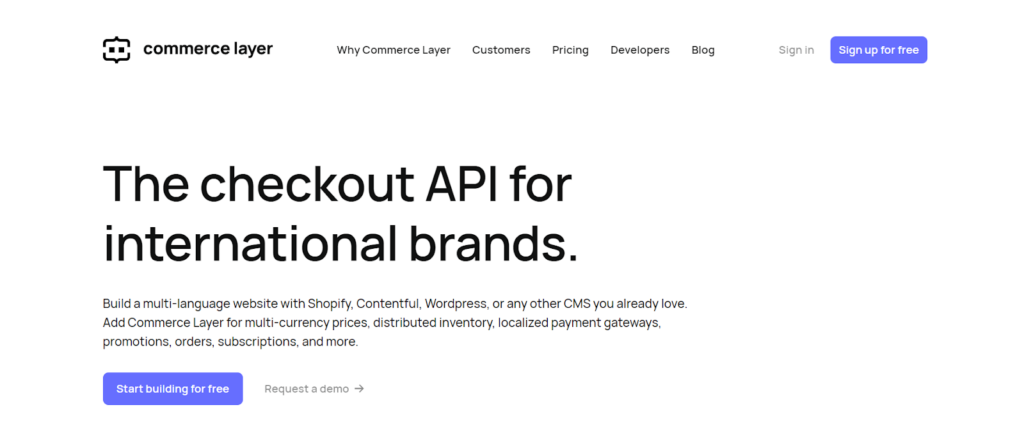
CommerceLayer homepage
Commerce Layer cuts to the list because it lets you go the headless way easily.
What is a Commerce Layer?
Commerce Layer allows modern developers to build enterprise headless commerce. You need a Commerce Layer if your brand is fast-growing.
The headless solution is powerful yet simple to implement. Commerce Layer has an effective API for blistering websites. You can use it on any breed of the technology stack to scale a shoppable website.
What are the features of the Commerce Layer?
- API
- Customer Touchpoints
- Inventory Optimization
What are the pros of the Commerce Layer?
- very comfortable to use
- multi-purpose benefits
- simple structure
- integrate POS software and sell in-store
- flexible with wearable and voice devises
What are the cons of the Commerce Layer?
- not a self-explanatory interface
What is the price of the Commerce Layer?

Commercelayer pricing plan
Commerce Layer lets you start free of cost but with limited features. Businesses with comprehensive requirements will have to connect with the Layer’s team.
Commerce Layer gives a free trial for you to explore.
Who is Commerce Layer best suited for?
- Commerce Layer is for you if you have a fast-growing brand
- Best for digital-first brands looking to go headless
- Businesses looking to scale internationally
- Merchants looking for reliable and future-proof solutions
Best headless commerce platform #7: Contentful

Contentful homepage
No headless eCommerce platform list is complete without contentful.
What is Contentful?
The entire point of having a headless eCommerce is to market your materials on different platforms without being caught in the hassle. Contentful lets you break the non-omnichannel experience and powers digital experiences’ speed, reliability, and performance.
Contentful integrates many tools using APIs and unites content in one repository. Quick turnaround time for marketing materials and content from one repository makes it a must-have headless CMS for eCommerce.
What are the features of Contentful?
- Data Synchronization
- Access Controls/Permissions
- Digital Asset Management
- Collaboration Tools
- Offline Access
- Content Management
- Archiving & Retention
- Document Management
- Information Governance
- File Sharing
- Mobile Access
- Search/Filter
- Workflow Management
- Version Control
What are the pros of Contentful?
- effective for writing and managing content
- safe and well-designed CMS
- positive experience
- friendly configuration
- stable CMS
- clear data structure
- auto configurable APIs
- ease of use and scalability
- manage a large amount of data
- loads quicker than many CMS
What are the cons of Contentful?
- you may feel lost if you’re not aware of what you’re up to (tricky navigation)
- content preview right before publishing is limited
- offer only mail support
- lack of secure log to record all the events
- expensive
- the learning curve is big
What is the price of Contentful?
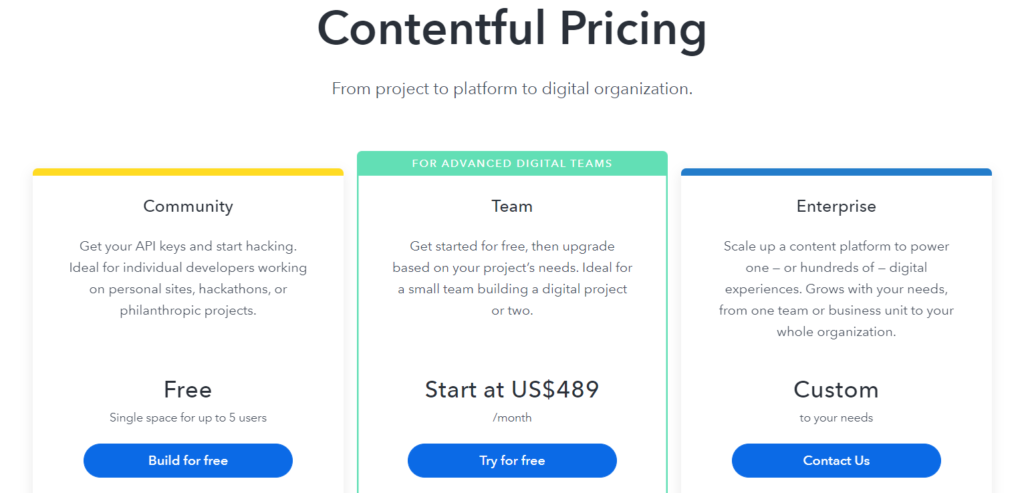
Contentful pricing structure
Contentful starts at 489$ per month. It has a free trial and a free version too.
Who is Contentful best suited for?
- Contentful is best if you want to quickly deliver digital experiences across multiple channels.
Best headless commerce platform #8: Kentico Kontent

Kentico Kontent homepage
I couldn’t resist adding Kontent with a “K.”
What is Kentico Kontent?
Kontent, the name is self-explanatory. It has something to do with the headless CMS platform. It has easy-to-use content management tools for content marketers.
Developers no longer have to rely on it, and they can engage themselves in building interactive and seamless shopping experiences. Kontent allows marketers to focus on creating content without needing developers involved.
What are the features of Kentico Kontent?
- Text Editing
- Mobile Access
- SEO Management
- SDKs
- Content Publishing Options
- API
- Full-Text Search
- For Marketers
- Access Controls/Permissions
- Document Classification
- Multi-Channel Marketing
- Video Support
- Reporting/Analytics
- For Developers
- Customizable Templates
- Version Control
- Website Management
What are the pros of Kentico Kontent?
- effective customer support
- allows good customization
- simple and easy to use
- flexibility in content taxonomy
- easy implementation
- powerful user interface
- flat learning curve
- flexible and adaptable from the user’s point of view
- seamless integration with the modern tech stack
What are the cons of Kentico Kontent?
- may need upfront knowledge to reap the best out of the platform
- requires developers to make basic changes
- the price tag is high, and there’s no cheaper plan for small businesses
What is the price of Kentico Kontent?
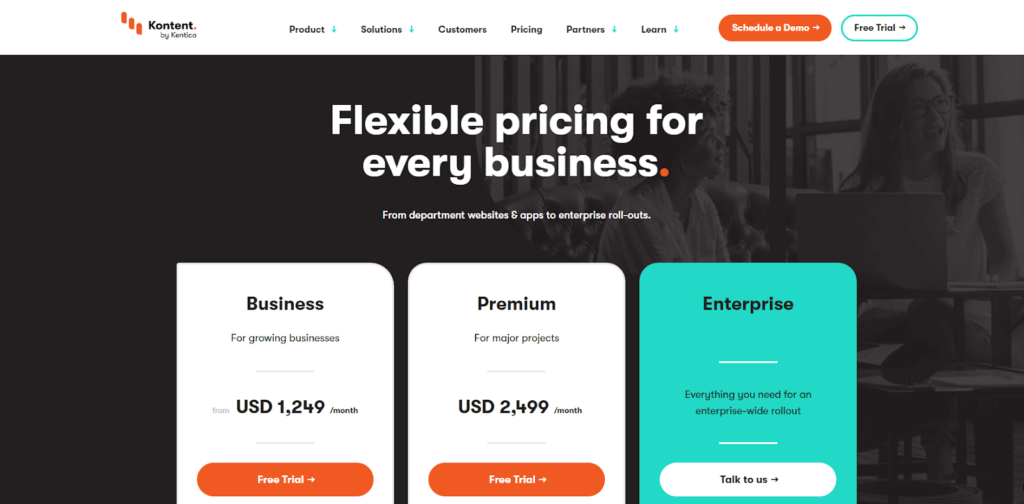
Kontent pricing structure
Business plan: $1249.00 /month
Premium plan: $2,499/month
Enterprise plan: Connect with Kentico
Kontent has a free trial version for 30 days. You also get a free version to use.
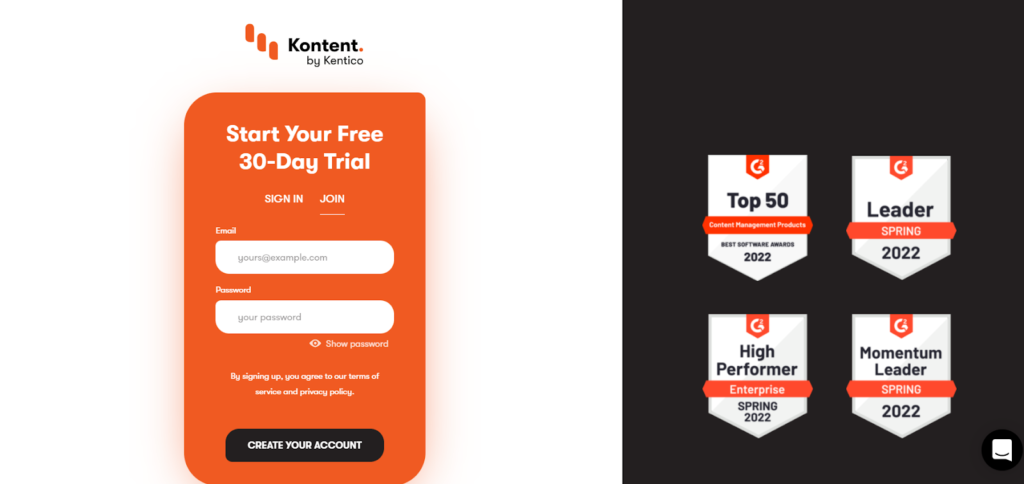
Kontent 30-day free trial form
Who is Kentico Kontent best suited for?
- Kontent is good for medium and large enterprises.
- Digital agency clients looking to streamline amazing shopping experiences
Best headless commerce platform #9: Shogun
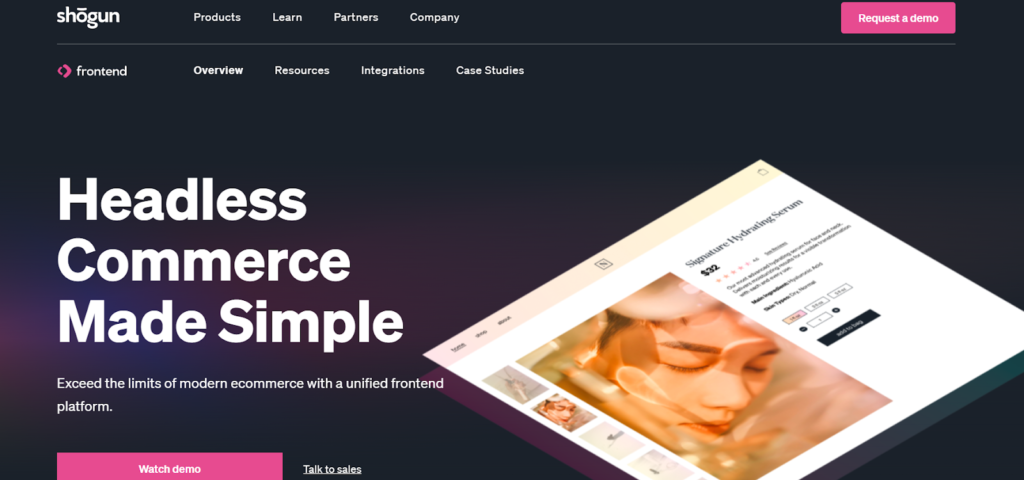
Shogun Homepage
Shogun comes first to my mind whenever the talks are about front-end headless platforms. I can give direct insights into how amazing the Shogun experience has been because Aureates is partners with them.
My team has worked with them directly and has created some of the best headless eCommerce in the industry.
What is Shogun?
The Shogun Frontend platform lets you build phenomenal headless shopping experiences. Businesses looking to gain control over design customization and wishing to deliver blazing-fast websites can use Shogun as a handy platform.
You can push your eCommerce team to create custom elements in almost no time without putting on much time into coding. Shogun does the everyday tasks for you much better.
What are the features of Shogun?
- Content Management
- Customizable Templates
- AB Testing
- API
- Access Controls/Permissions
- Integrated Development Environment
- Inventory Optimization
- SEO Management
- Web/Mobile App Development
- Drag & Drop
- Reporting/Analytics
What are the pros of Shogun?
- easy to learn
- anyone can use it
- reduces loading time for desktop and mobile
- limitless customization potential
- less code, more control
- simplified content management
- codeless store update
What are the cons of Shogun?
- no free plan is available
- the prices are low
- not many templates
What is the price of Shogun?3
Shogun pricing differs across multiple pricing platforms.
Shogun price for Shopify
Build: $39/month
Measure: $99/month
Team: $299/month
Enterprise: Custom plan
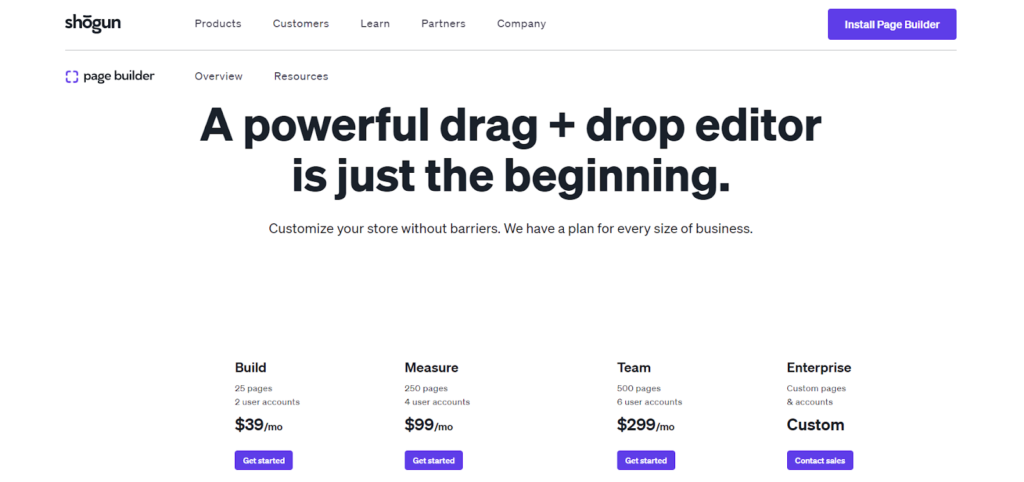
Shogun pricing for Shopify
The shogun pricing for BigCommerce

Shogun pricing for BigCommerce
Build: $49/month
Measure: $149/month
Optimize: $349/month
Shogun also offers a 7-days free trial.
Who is Shogun best suited for?
- If you want more from Shopify Plus and BigCommerce, Shogun’s headless frontend is the way.
- Small to enterprise-scaled businesses
Best headless commerce platform #10: Alokai (Formerly Vue Storefront)
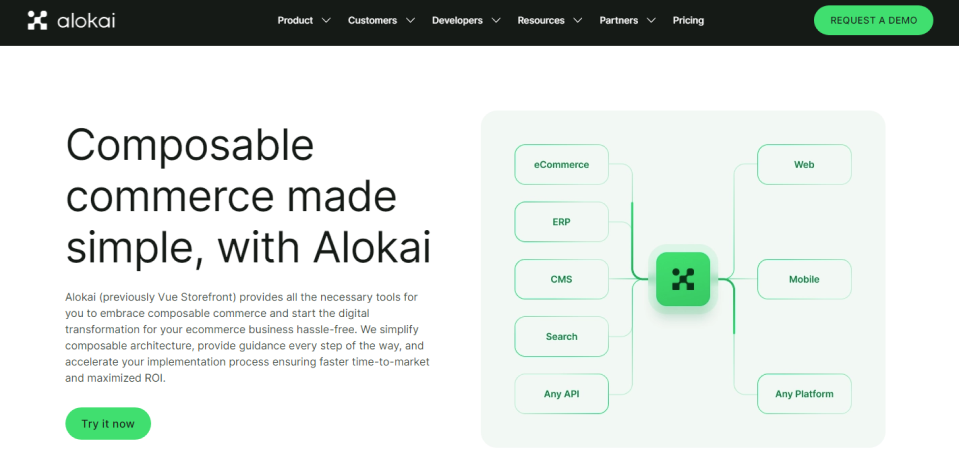
Alokai (Formerly Vue Storefront) homepage
It often doesn’t happen when you talk about headless commerce platforms, and Alokai (Formerly Vue Storefront) is not on the list. 🙂
What is Alokai (Formerly Vue Storefront)?
Alokai (Formerly Vue Storefront) is a headless eCommerce frontend that can be connected with any eCommerce platform like Magento, Shopify, or BigCommerce.
You can improve your front-end without making a single change at the backend. It ends the interdependency between the two. Alokai (Formerly Vue Storefront) lets you create Progressive Web Apps for any eCommerce platform. Many long-time Magento merchants look at Alokai (Formerly Vue Storefront) as an Adobe commerce alternative.
Read our comparison between Magento PWA studio and Alokai (Formerly Vue Storefront) before making any decision.
What are the features of Alokai (Formerly Vue Storefront)?
- Cataloging/Categorization
- Abandoned Cart Saver
- Credit Card Processing
- eCommerce Management
- Order Management
- Inventory Management
- SEO Management
What are the pros of Alokai (Formerly Vue Storefront)?
- solution for flexible eCommerce platforms
- helps fasten the Google page speed score
- easy to set up, open-source headless solution
- the large community of active users
- regular updates
- makes use of new technologies very well
- supports elastic search and GraphQL to make development journeys more powerful and efficient
What are the cons of Alokai (Formerly Vue Storefront)?
- hard for merchants to use
- the solution is only for developers
- missing features like catalog rules
- limited functionalities
- huge learning curve
What is the price of Alokai (Formerly Vue Storefront)?
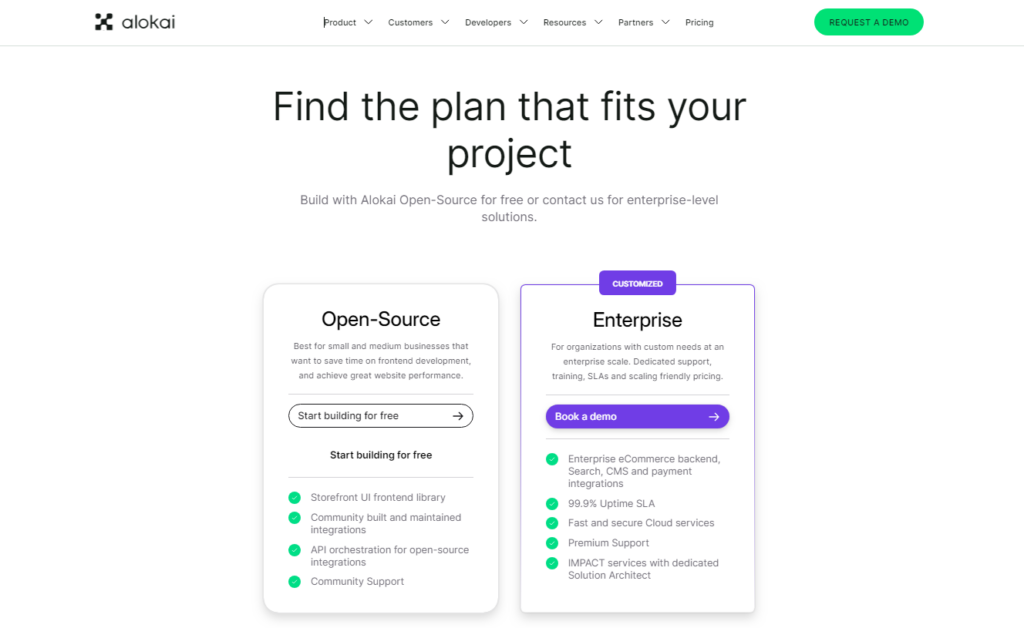
Alokai (Formerly Vue Storefront) pricing
Alokai (Formerly Vue Storefront) doesn’t mention the price. You’ll have to reach out to the team for a price discussion. But it has a free trial and a free version.
Who is Alokai (Formerly Vue Storefront) best suited for?
- You’d want Alokai (Formerly Vue Storefront) if you’re looking for a headless frontend platform for Magento or Progressive web apps for Shopify.
- A perfect suite for mid-market and enterprise commerce
Good news: We have developed a Shopify-VueStorefront connector for Vue that will save thousands of dollars in customization.
Best headless commerce platform #11: Commercetools

Commerce Tools homepage
commercetools makes it to the list because it’s one of the leading headless platforms.
What are Commercetools?
Commercetools are used to build next-generation B2B and B2C eCommerce. So far now, the legacy suits have restricted eCommerce websites from customization and scalability. Commercetools breaks the need for legacy tools with its headless and API-first approach.
You can use this headless platform to make a multi-tenant SaaS commerce platform for two reasons:
- Commercetools is cloud-native
- Commercetools deploys flexible microservices
Global 500 SaaS enterprises use a headless commerce approach with Commerce Tools to produce seamless experiences at different touchpoints.
What are the features of Commercetools?
- Web/Mobile App Development
- Content Management
- CRM
- SEO Management
- Returns Management
- Email Marketing
- Promotions Management
- Conversion Tracking
- Reviews Management
- Kitting
- Multi-Store
- Multi-Channel Marketing
- Templates
- Customer Touch Points
- Data Security
- Mobile Access
- Inventory Management
- API
What are the pros of Commercetools?
- informative documentation
- microservice-architecture is scalable
- supports cloud-native platform
- no need to use SQL
- APIs are easy to extend
- requires less maintenance
- ever-expanding eCommerce solution
What are the cons of Commercetools?
- there are no modern frontend SDKs
- complex integration with 3rd party platforms
- The pricing slab is not very customizable
- data mapping limitations
What is the price of the Commercetools?
Commercetools hasn’t disclosed their prices yet. You can contact the vendor for the price. However, you can learn the ins and outs during your free trial version.
Some secretive customers have shared the price
- Implementation → $300,000 – $1 Million
- License Fees → $200,000/year – $500,000/year
- Specialized resources→ $150,000/year
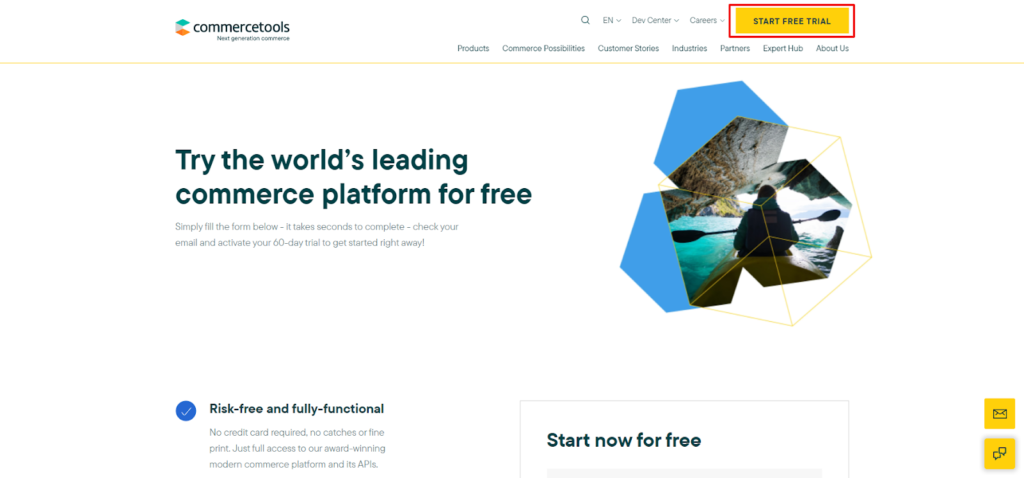
Commerce tools free trial offer
Who are the Commercetools best suited for?
- Go for Commercetools should you need eCommerce solutions for niche industries like
- retail,
- electronics,
- travel,
- fashion,
- automotive,
- wholesale,
- entertainment,
- telecommunications.
- B2B and B2B SaaS solutions
Best headless commerce platform #12: Elastic path Commerce
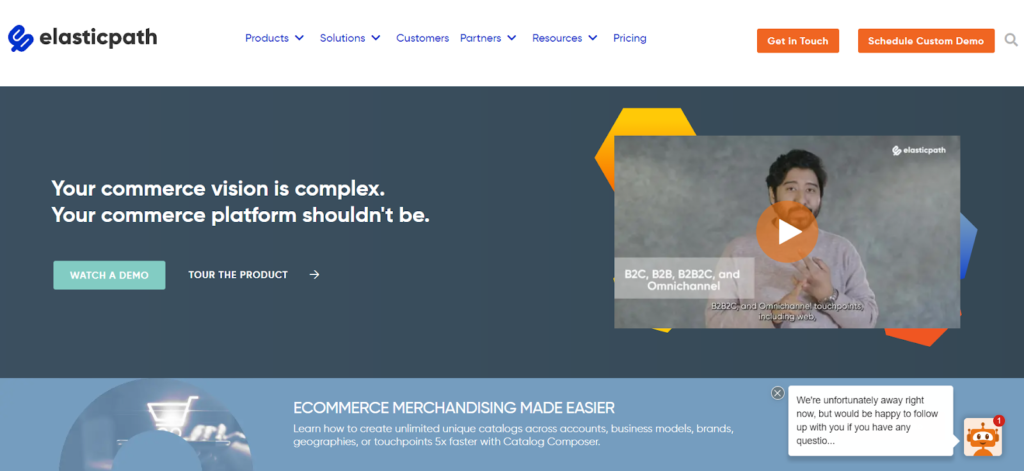
Elastic path homepage
If you’re talking about headless platforms and flexibility in the same place, you will have to talk about elastic path commerce.
What is Elastic path Commerce?
Elastic Path Commerce is a platform that puts business on the agility pedestal. Flexibility has been a long-talked issue in traditional commerce. Elastic path applies a headless approach with the patented eCommerce technologies.
Its flexible enterprise commerce solution helps you create an omnichannel experience throughout the sales funnel in the customer journey. You can expect your business to have higher engagement and revenue with the Elastic path.
What are the features of Elastic path Commerce?
- Inventory Tracking
- Shipping Management
- Shopping Cart
- Categorization/Grouping
- Promotions Management
- Order Management
- Communication Management
- Templates
- Multi-Store
- API
- Integrated Development Environment
- Inventory Control
- Inventory Management
- Data Security
- Reordering
- Reporting/Analytics
- Content Management
- Web/Mobile App Development
- Conversion Tracking
- Mobile Access
- eCommerce Management
- Returns Management
- Bulk Ordering
- Payment Processing
- Inventory Optimization
- Reviews Management
- Marketplace Integration
- Cataloging/Categorization
- Customer Touchpoints
- Payment Options
What are the pros of Elastic path Commerce?
- Has a smooth and reliable API.
- easy access to the web tools
- easy to use
- flexible business solution module
- API is high-speed
- has plenty of advanced features
- a better developer experience
- amazing billing options
What are the cons of Elastic path Commerce?
- need bug fixes at some points
- may not feel user-friendly to everyone
- learning-curve is huge
- needs improvement in the CloudOps
- the upgrade system takes a lot of time
What is the price of Elastic path Commerce
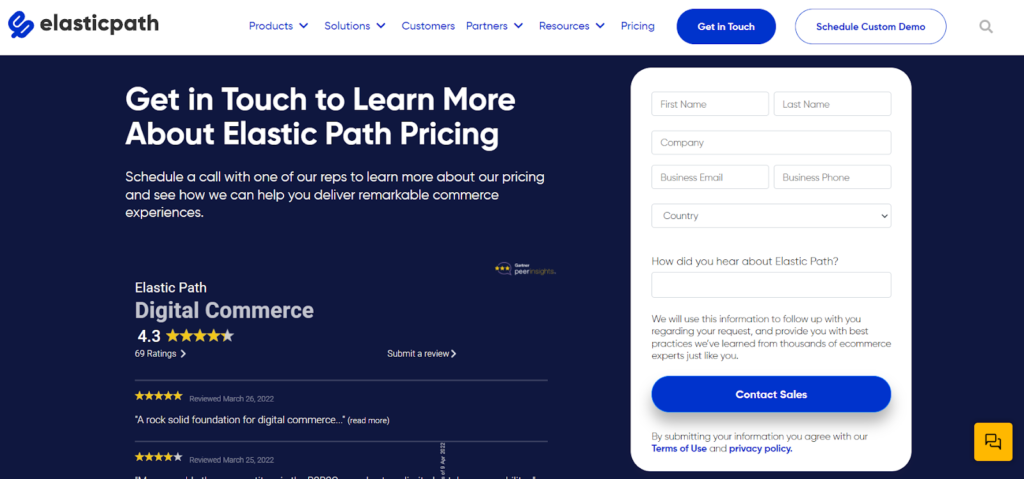
Elastic path contact us form
The pricing for Elastic Path is divided into two parts. It starts with the upfront pricing (licensing fee). Then the pricing model switches to the transaction model. You’ll be billed over the transaction volumes. There’s no free trial or free version.
You’ll have to get in touch with its executive to learn about its pricing. The pricing may start at $50000.00 based on your usage every month.
Who is Elastic path Commerce best suited for?
- Elastic Path is one platform with many business models.
- Power up your B2B, B2C, and B2B2C business with EPC
Best headless commerce platform #13: Nacelle

Nacelle homepage
The nacelle is new. But it still manages to get past much headless commerce. Why? You’ll know the reasons.
What is Nacelle?
The nacelle is a headless platform for eCommerce merchants sick of slow websites and terrible mobile conversion rates. Your website needs a flexible and scalable solution to go big in the future. Nacelle does everything traditional platforms do, but everything at a 3X pace.
Let’s say you wanted a lightning-fast store that gives you a 25%+ increase in conversion. Nacelle helps you develop progressive web apps (PWAs) that run faster than any ordinary store. Check out how PWA increases web app conversion rates. Also, check some other PWA benefits that nacelle can offer.
In general, you can expect an increase in
- higher traffic
- better conversion rates,
- larger average cart sizes
What are the features of Nacelle?
- Mobile Access
What are the pros of Nacelle?
- fast, modern-PWA
- excellent customer support
- cutting-edge commerce tools
- has a less complex backend
- great development experience
What are the cons of Nacelle?
- the learning curve is big
What is the price of Nacelle?

Nacelle contact us form
Nacelle bills you $5000.00 per month for every user. Unfortunately, there’s no free version or free trial.
Who is Nacelle best suited for?
- The nacelle is for you if you’re concerned with scaling and boosting conversions.
- You’d also love it if an eCommerce team looking for high mobile performance and a great tech stack arrangement.
Best headless commerce platform #14: Fabric
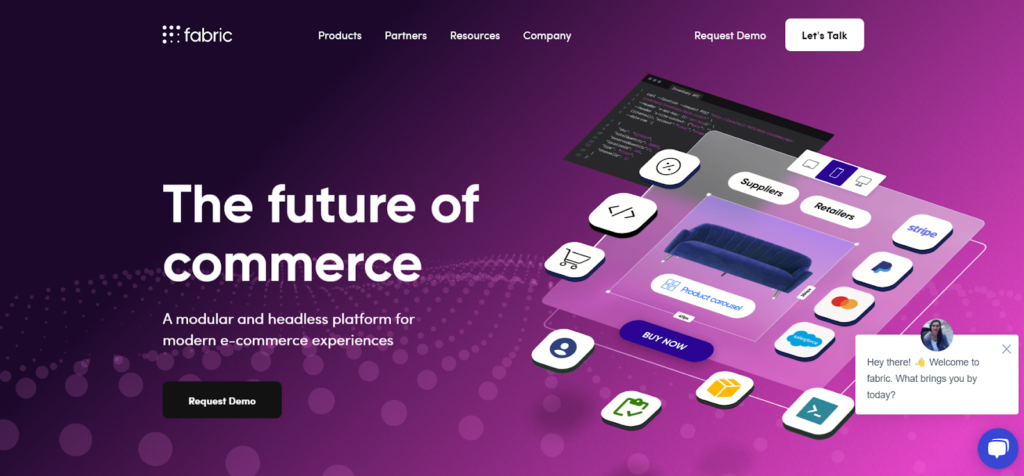
Fabric Homepage
Though Fabric copy says “The Future Of Commerce,” I feel it’s already the present of headless commerce.
What is Fabric?
Fabric is the headless platform designed to increase the growth of your eCommerce. The platform has an open and modular design that lets you control the web elements at the modular level.
Ecommerce retailers can use fabric to grow their revenues by 3X numbers.
What are the features of Fabric?
- Cataloging/Categorization
- Inventory Optimization
- Bulk Ordering
- Search/Filter
- Promotions Management
- Reporting/Analytics
- Order Tracking
- Web/Mobile App Development
- Integrated Development Environment
- Marketplace Integration
- Order Management
- Inventory Control
- Shopping Cart
- Inventory Management
- Payment Options
- Reordering
- Content Management
- Returns Management
- Shipping Management
- API
- eCommerce Management
- SEO Management
- Mobile Access
What are the pros of Fabric?
- an “API-centric” approach
- omnichannel architecture methodology
- accelerated roadmaps with modular architecture
- faster time-to-market
- ease of deployment
- the ultimate level of support
- smooth transition of websites without re-platforming
- flexible and scalable commerce tool
- easy to use
- deals with complex custom pricing very well
What are the cons of Fabric?
- no noticeable issue with fabric so far
- steeper learning curve
What is the price of Fabric?
Fabric charges $6000.00 every month per user. You can’t learn it for free as it doesn’t have a free version or free trial.
Who is Fabric best suited for?
- Fabric best suits brands and eCommerce merchants looking for scalable and functional tools.
- You’ll also love Fabric if you need microservices and APIs to generate an omnichannel experience.
Best headless commerce platform #15: Bloomreach
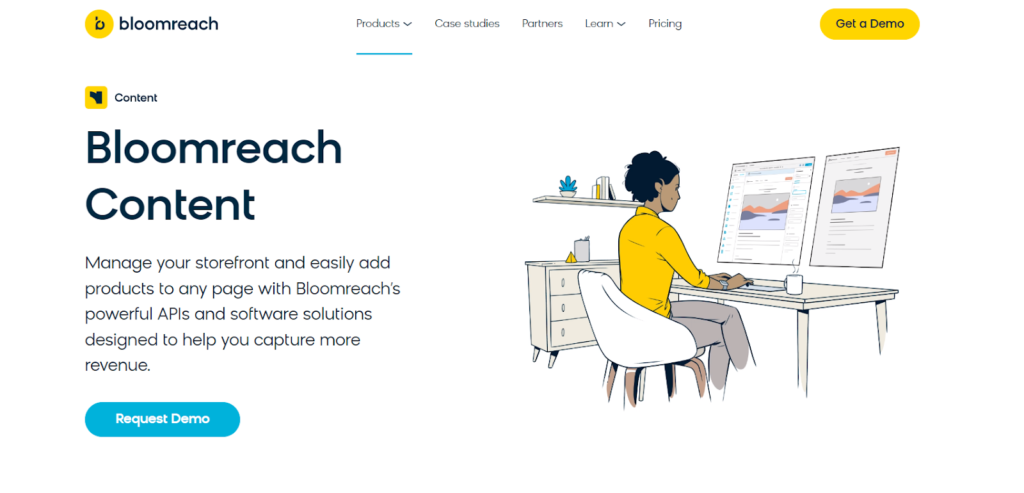
Bloomreach homepage
I wanted to end the list with a bang. What’s better than Bloomreach for this?
What is Bloomreach?
Bloomreach is a headless commerce platform that creates amazing cloud experiences. It’s a #1 platform if you want to deliver a personalized experience to your customers. The platform allows you to build a super-customizable journey for the shoppers.
You can also manage the storefront with Bloomreach’s API. For decades, adding products to any page has been a hassle. Bloomreach’s headless solution is designed to solve the problem.
What are the features of Bloomreach?
- User Interaction Tracking
- Digital Asset Management
- Workflow Management
- Data Integration
- Document Management
- Website Visitor Tracking
- Customizable Templates
- Campaign Management
- Full-Text Search
- Customer Profiles
- Content Publishing Options
- Access Controls/Permissions
- Pageview Tracking
- Segmentation
- Customizable CTAs
- Drip Campaigns
- Search/Filter
- Text Editing
- Approval Process Control
- Data Visualization
- Indexing
- Activity Dashboard
- Dynamic Content
- Functions/Calculations
- Conversion Tracking
- Rich Text Editor
- Referral Tracking
- Configurable Workflow
- AB Testing
- Version Control
- Goal Setting / Tracking
- Third-Party Integration
- Customer Segmentation
- Alerts/Notifications
- Lead Qualification
- Analytics
- Rule-Based Publishing
- GDPR Compliance
- Template Management
- Predictive Modeling
- API
- Collaboration Tools
- ROI Tracking
- Data Connectors
- Lead Management
- Personalization
- Campaign Analytics
- Content Management
- Brand Management
- SEO Management
- Marketing Automation
- Private Dashboards
- Multi-Channel Marketing
- Public Dashboards
- Image Editing
- KPI Monitoring
- Time on Site Tracking
- Website Management
- Mobile Access
What are the pros of Bloomreach?
- useful data insights
- versatile software
- easy to understand
- logical upgrades
- helpful and insightful support staff
- feature-rich software
- well-designed software
- responsive and knowledgeable support team
- easy integration
What are the cons of Bloomreach?
- may feel complex to implement
- difficult than ordinary CMS
- CMS freezing issue is quite common
- some chinks in the feature need to be worked out
- lots of features make it a bit complex suite to use
- expensive
- The mobile version still needs a UI overhaul
What is the price of Bloomreach?

Bloomreach contact us form
Bloomreach has not provided pricing details, but you don’t have any free version or free trial to get your hands dirty.
Who is Bloomreach best suited for?
- Bloomreach is a powerful platform for all the businesses
- Best for you if you need a multi-channel content delivery solution
- Suited for
- retail,
- distribution,
- manufacturing,
- transportation,
- hospitality
How To Choose Headless Commerce Platforms For Your Business?
I know the list doesn’t solve the problem for you. Then how do you pick the best headless platform for your organization?
Trust me; if you can answer what you need headless commerce for, you can answer what platform you need.
So ask yourself if you need more control over the
- front-end customization?
- Back-end system?
- CMS?
Here’s a step-by-step process to identify the top headless commerce platform for business.
Step #1: Understand your business case more closely
- Are you looking for agility?
- Do you want to use modern technology to give a competitive digital experience?
- What are your thoughts on a personalized multichannel experience?
- Do you want to provide the best retail experience?
If you can answer these questions, you can say you understand your business case clearly.
Step #2: Know more about the headless approach
While shopping for new things may be tempting, you shouldn’t take headless commerce as grocery shopping.
Take your time to understand these concepts:
- Web-first vs. content-first approach
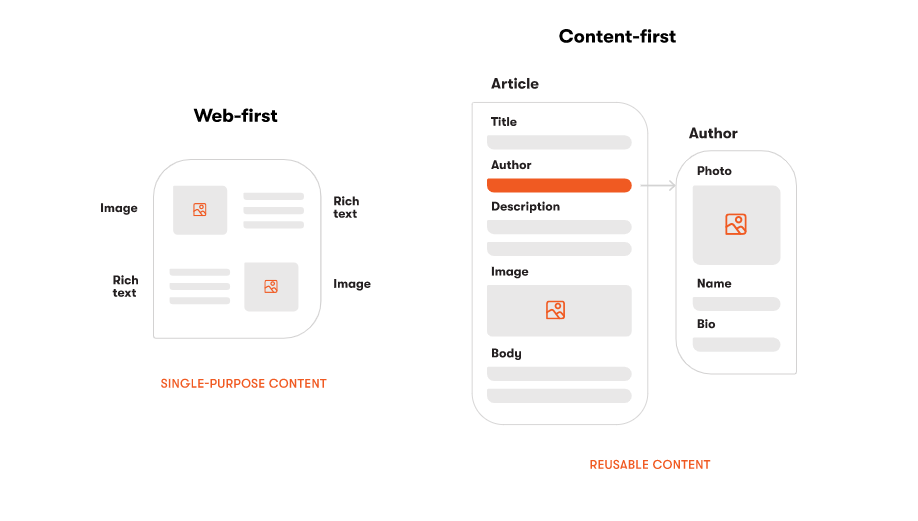
- Monolith vs. microservices architecture
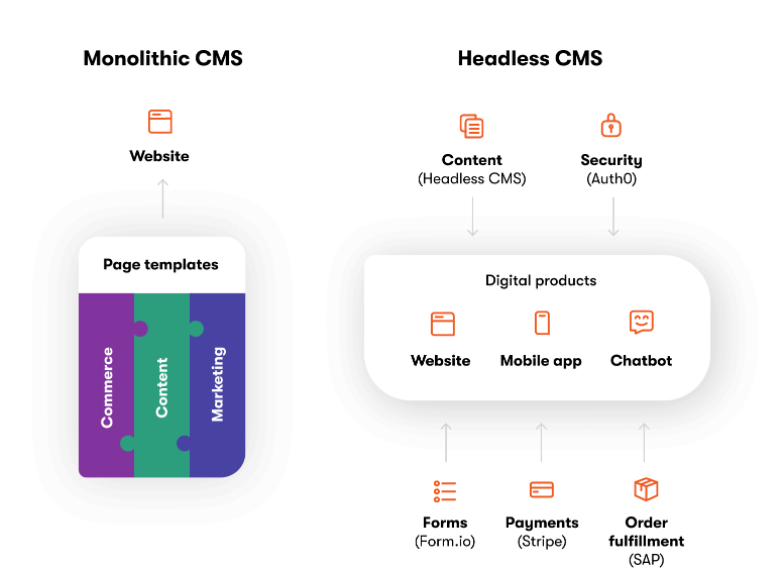
- Hybrid CMSs
- The self-hosted model managed to host PaaS vs. SaaS
Step #3: Check the suitable pricing
All the headless commerce platforms have differing prices.
- figure out the most important features you need,
- map their availability with the headless platform, and
- check the best pricing rate.
Step #4: Check how powerful the support is
You may feel attracted to the cheaper headless solutions. But the price is not the only factor determining a good headless platform. You would want to consider the quality of customer support.
Look! Most headless tools are complex. They continuously need support from the community and dedicated helpline executives. It’s all the more reason why you can’t ignore 24*7 support.
Step #5: Evaluate the headless tool
I think this should come up a bit on the list. Nevertheless, it’s the most important learning process about headless platforms.
Things you should watch out for:
- Do they have flexible APIs?
- Do they have developer training modules?
- How good is the learning documentation?
- How fast do you hear from the headless vendor?
- Do solutions match your business case?
- Can the headless solution integrate with your existing commerce?
- How easy is it for you to start using the headless platform?
Once you have evaluated the platform, it’s time to evaluate its makers.
Step #6: Evaluate the vendors and their proposals
You’re getting a better sense of the vendor at this stage.
- Learn what you’re paying for. Get the list ready by them!
- Do they listen to your ideas?
- What are their consulting services?
- What does their company’s culture look like?
Summary of Headless Commerce Platforms
I gave you the reasons to go headless. And then the list of the top 15 headless platforms that I feel can make a difference in the eCommerce industry.
The essential part of running an eCommerce business is maintaining a competitive edge over your rivals. Headless at the moment is one way to deliver an amazing digital experience.
Let me know what’s your preferred headless commerce in the comments. Also, color me wrong if I haven’t mentioned any headless platform that I should have. 🙂






This is complete information & I m searching the topics in Google for a few days for details information about headless eCommerce. I read the blog of Forbes, entrepreneur but I didn’t get the answer from your blog, I m completely satisfied now. thanks nice work
this is a very interesting article. headless ecommerce is a unique combination but a interesting thing.